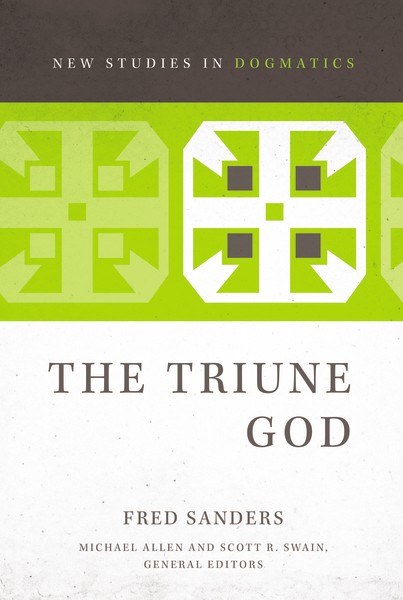
Sending of the Son, from the Hours of Catherine of Cleves (ca 1450)
One of the organizing principles in my forthcoming book The Triune God (Dec. 6; available now for pre-order) is divine sending. The idea of God sending God is fundamental to this whole scheme of presenting the doctrine of the Trinity, and is especially prominent in chapter 5 (“God Who Sends God”).
Just Sending
Here’s one way to think about the task: Instead of spelling out the doctrine of the Trinity from an analysis of the most important revealed names like Father, Son, and Holy Spirit, you could spell out the doctrine by analyzing the fact of divine sentness. The reason to do this is not because the revealed names Father and Son are unstable or inadequate. On the contrary, they are so luminously clarifying and conceptually rich that they threaten to draw all of our attention and keep it. So avert your eyes from the terms Father and Son for a moment and consider the basic datum that in the fullness of time, God sent God and God. That is, God (the Father, but we’re not saying that yet) sent God (the Son, but again, defer that label) and God (the Holy Spirit, but again, sssshhh).
God sent Jesus and the Spirit: that’s a sentence about the gospel of salvation, and it’s a sentence rich in theological implications.
How much of trinitarian theology can be derived and displayed simply from reflection on divine sentness? Quite a bit, I think. And it’s worth carrying out that exercise because what we learn from sentness is actually foundational to what we learn from the revealed names. More on that in a moment. First, dig into sentness itself just a bit.
A Theology of Sentness
Jesus is God, but he is God as sent; the Sent God. That he is God entails unity; that he is sent entails distinctness. Jesus is not God who sends, but God who is sent. And he is not a something or someone sent from God and different from God (like Moses, angels, anything created, apostles), but God sent.
To think the thought “God sends God to us” instead of the simpler thought “God comes here to us,” you have to begin to grasp some kind of polarity or distinction in God. If you think of the situation spatially: in order to send, God must stay where he is and send out something to us. Otherwise we wouldn’t speak of sending at all, but only coming.
But then what are we saying? The omnipresent God doesn’t stay in one place and send something to another place where he once was not. The omnipresent God sends nonspatially. God sending God is not a case of God leaving one place and arriving in another, nor of staying in one place and separating an envoy who grows more distant from him as he draws nearer to a target, nor expanding outward to cover more territory, nor verbally broadcasting across a distance –though verbally broadcasting may be a helpful notion, because when I send out a word, it doesn’t depart from me in order to arrive at you in quite the same way a tennis ball or a messenger does.
The sent God was never halfway to us; he did not pass through a midpoint on his way from there to here. The sending we are talking about is some kind of nonspatial from and to, a whence and a whither that start without a where, a spiritual launch and a physical landing, in the case of the word become flesh.
The Kind of God Who Can Send God
All of this is really just incarnational theology, not yet Trinitarianism. To take the step into Trintarianism we would need to make sure we were consistently including the Holy Spirit (omitted here for the sake of sentence clarity), and we would need to make sure we were talking not just about the sending, but about the presupposition behind the sending.
For an unchanging God to send God in the fullness of time, God must stand by nature in a relation of Send-able to Sent-able. There must be a relation in God’s own being that is the ground of God sending God, of God being sendable by God. That eternal relation in God’s own being must be, at the very least, a principle of distinctness, since all is one in God except where there is an opposition of relation. But it must be more. It must be some going-forth from God to God in God; some eternal, internal procession. It must be some kind of proceeding of God from God that results in unimaginably perfect unity rather than scattering diversity.
That is no doubt a weird way to put it, but recall that we are intentionally holding off on the revealed names of Father and Son. We are also attempting to come in from a strange angle to say what the central tradition of Trinitarianism confessed in the terms “God of God, Light of Light, True God of True God.” That tradition went on to develop the important terms mission and procession. The missions, as Augustine says, reveal the processions. The processions, as Aquinas says, have temporal effects added to them, resulting in missions.
Aquinas says a lot more, and there’s a lot more to say: “In one sense,” he says, “only the Father sends the Son,” because the Father is the principle of the person of the Son. But “in another sense, the whole Trinity sends the Son” because God as such is the principle of the effect brought about (ST 1.43.8). Aquinas wraps up his vast treatise on the Trinity with profound reflection on the missions, that is, on the presuppositions and implications of a sent God.
Sending and the Names
 Of course in the book, I bring the revealed names back into the picture pretty quickly. No trinitarian theology could responsibly omit the terms that God himself has given us in Scripture for the Sending One and the two Sent Ones: Father, Son, and Spirit; Glory and its Effulgence; Speaker and Word and Breath.
Of course in the book, I bring the revealed names back into the picture pretty quickly. No trinitarian theology could responsibly omit the terms that God himself has given us in Scripture for the Sending One and the two Sent Ones: Father, Son, and Spirit; Glory and its Effulgence; Speaker and Word and Breath.
But holding those names in abeyance for a few pages has two payoffs. First, it lets you scrutinize sentness for all it’s worth. Doing so, you find in it tones and significations previously overlooked, as when Picasso spent three years painting mostly in blue and made us almost believe a painter didn’t need much else on his palette.
And second, highlighting sentness before turning to the names clarifies the relationship between these two funds of trinitarian insight. Scripture gives us a set of names for the three persons of the Trinity partly because through these names, God is equipping us to understand who and what he has sent to us for our salvation. “Father” and “Son” are the divinely-given names that answer the questions “Who sent who,” and “what must be true of God if the incarnation and Pentecost are true?” The missions are demonstrative; the names explicative.
The first benefit I consider a helpful and instructive technique for exposition. The second benefit I consider a reordering and reorienting of our knowledge of God’s self-revelation as Trinity.